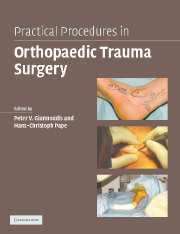Fractures of the acetabulum
from Chapter 8
Published online by Cambridge University Press: 05 February 2015
Summary
OPEN REDUCTION AND INTERNAL FIXATION (ORIF) OF POSTERIOR WALL FRACTURES – KOCHER–LANGENBECK APPROACH
Indications
Fractures of:
Posterior wall.
Posterior column.
Posterior column and wall.
Transverse fractures.
Transverse posterior wall and T-shaped fractures.
Pre-operative planning
Clinical assessment
Examination of the injured limb is essential, including the soft tissue envelope.
In cases of high-energy trauma examination for other potential associated injuries should be performed carefully.
The Advanced Trauma Life Support (ATLS) evaluation protocol should be followed.
Radiological assessment
Anteroposterior radiograph of the pelvis, as well as Judet views, can provide substantial diagnostic information in terms of fracture type and also indicate the need for emergency treatment (in cases of fracture dislocations of the femoral head) (Fig. 8.1a, b, c,).
CT scan will supplement the plain radiographs and important additional information can be obtained for the pre-operative planning (Fig. 8.2a,b,c).
Timing of surgery
Operative treatment is generally delayed for 3–5 days to allow stabilization of the patient's general status.
Two to four units of blood should be made available, depending on the extent of the fracture pattern.
Indications for emergency acetabular fracture fixation
Recurrent hip dislocation after reduction despite traction.
Progressive sciatic nerve deficit after closed reduction
Irreducible hip dislocation.
Associated vascular injury requiring repair.
Open fractures.
Anaesthesia
General anaesthesia at induction.
Administration of prophylactic antibiotics as per local hospital protocol.
- Type
- Chapter
- Information
- Practical Procedures in Orthopaedic Trauma Surgery , pp. 133 - 148Publisher: Cambridge University PressPrint publication year: 2006

